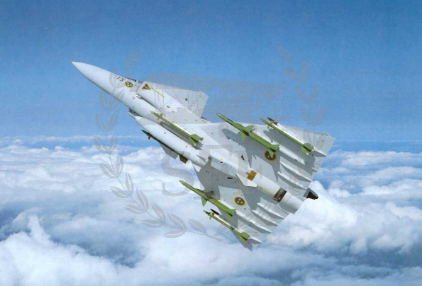Viggen mountain hangar
Here you can see a JA 37 Viggen being towed out of a mountain hangar. This is intended to illustrate the method that in the 50s and 60s was intended to be used to protect air force aircraft in the event of enemy attacks on the air bases.
JAS 37 Viggen
The aircraft shown here is a JA 37, i.e. the fighter version of the Viggen. This is a further development of the AJ 37 which was mainly an attack aircraft. The first flight with the Viggen took place on February 8, 1967. The attack version of the Viggen AJ 37 entered service with units in 1971. This was then further developed into a fighter version, the JA 37, which entered service with units in 1980. The aircraft was then in service until 2003.

Aircraft JA 37 Viggen. Image from the Swedish Aviation History Association.
Some data for the JA 37:
Engine: Volvo Aviation Engine RM8B
Crew: 1 person
Length: 16.43m
Span: 10.6 m
Max weight: 22,500 kg
Max Speed: Mach 2.2
Mountain hangars
After the Soviet Union had detonated its first atomic bomb in 1949, the threat of nuclear weapons became very much a reality for Sweden as well. The philosophy followed in the early 50s to protect the Air Force’s aircraft in the event of an attack was to build nuclear-proof rock and concrete hangars. Initially, the intention was to build 20 rock hangars and an equal number of concrete hangars. Of these ambitious plans, there were finally 5 rock hangars and no concrete hangar. These mountain hangars were built at F8 Barkarby outside Stockholm, F9 Säve (the hangar you are now standing in), F13 Bråvalla outside Norrköping, F16 Ärna outside Uppsala and F18 Tullinge outside Stockholm. These hangars protected well against nuclear weapons of “Hiroshima” size, 15 – 20 kton, but were judged not to provide adequate protection against nuclear weapons larger than about 1 Mton. In addition to these, some air flotillas had older mountain hangars of the same type as the “old mountain” at F9 Säve, which were not nuclear-safe.
The reason why there were not more mountain hangars was partly that they were expensive to build, and that a different philosophy had been developed for how the aircraft should be protected. Instead of gathering the aircraft in large nuclear-safe hangars, which with the increasingly large nuclear weapons of later times may no longer be so safe, the aircraft would be spread out over many bases with a significantly smaller number of aircraft at each base. These bases were so-called military airfields and road bases. The intention was that there would be 70-80 bases of this type.

The mountain hangar at F9 Säve. Image from Aeroseum.
